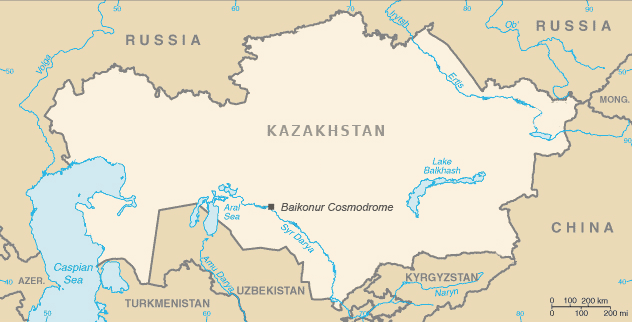Baikonur
BAIKONUR IS THE former Soviet Union's primary space launch facility. In the early days of the Soviet space program, rockets were launched from Kasputin Yar, a small field in the lower VOLGA RIVER basin not far from Stalingrad (modern Volgograd). However, this launch facility had numerous problems. Mists rising from the Volga River frequently delayed or altogether prevented scheduled launches. The flight path went over several settled areas, raising significant safety concerns if a rocket were to fail catastrophically in atmosphere. Worse, launches could be monitored by an American base in nearby TURKEY, an unacceptable situation to a government for whom security was considered essential.
As a result, the Soviet government decided to create a new, larger base in a remote, secure area that would still be accessible by rail and water links to the industrial centers of the western Soviet Union. Construction began in June 1955 near the village of Tyuratam in the Kazakh Soviet Socialist Republic (one of the 15 constituent republics of the Soviet Union), not far from the ARAL SEA. The Soviet government acknowledged the launch facility's existence in 1961, but in the secrecy of the time, called it the Baikonur Cosmodrome, after the railroad town of Baikonur nearly 239 mi (385 km) away. Western journalists were not permitted to visit the 600-square-mi (1,554-square-km) facility until 1989, under Soviet leader Mikhail Gorbachev's program of glasnost or openness.

COSMONAUT'S WALK
The base complex started as a cluster of low, white buildings and concrete blockhouses on the sandy desert, an environment more reminiscent of the American White Sands test range of NEW MEXICO or the rocket test stands of Edwards Air Force Base in CALIFORNIA than the oceanfront vistas of Kennedy Space center at Cape Canaveral, FLORIDA. The equipment in the underground control center was reminiscent of those used on Mercury launches; bare-bones oscillographs, radar scopes, and the like with little in the way of advanced computer technology. The original Baikonur launchpad included an enormous four-part service structure that surrounded the rocket. Interestingly enough, the elevator stopped somewhat short of the top, so that technicians and cosmonauts going to the capsule had to climb a set of steps known as the “cosmonaut's walk.”
The technicians and scientists working at Baikonur lived in nearby Zvyezdograd (Star City). This mediumsized town was a purpose-built settlement of the sort the Soviets often created near a major project to house its workers. Zvyezdograd is often lumped together with the cosmodrome proper as Baikonur.
The original Sputnik satellite was launched from Baikonur, as were many other important satellites and all the Soviet Union's manned launches. The Buran space shuttle was also launched from here in its single remote-controlled flight and was brought to land on the cosmodrome's landing strip. (It has subsequently been taken to Moscow and turned into an amusementpark ride.)
In a long-standing launch tradition, all Soviet and post-Soviet Russian rockets are always rolled out of their assembly building at 7 A.M. local time, commemorating the hour the Vostok rocket was rolled out for Yuri Gagarin's historic flight on April 12, 1961, in which he became the first human being to fly in space. Unlike U.S. rockets at Kennedy, Russian rockets are transported horizontally on a special rail car and are cranked upright at the pad.
Following the 1991 dissolution of the Soviet Union, Baikonur belonged to the newly independent republic of KAZAKHSTAN. Nursultan Nazarbayev, the new president of Kazakhstan, founded the Kazakh Institute of Space Research to coordinate with Russia in operating the Baikonur Cosmodrome. Russian economic problems have led to serious deterioration of the facilities, and most of the personnel are aging, as no younger scientists and technicians have been hired. However, following the February 1, 2003, crash of the U.S. space shuttle Columbia and the grounding of the remainder of the shuttle fleet, the Russians bore the full burden of launches to keep the International Space Station manned and operating, in spite of severe economic difficulties.